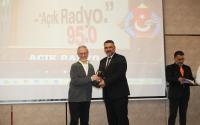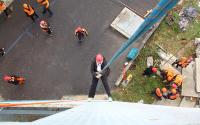 Critics say the US is exaggerating the terrorism threat in Africa |
8 August 2005Catherine Fellows
Washington believes the Sahara desert is a vast ungoverned wasteland and, hence, a haven for terrorists.
But critics say the US is exaggerating the threat and fomenting trouble.
Up to 1,000 US personnel and the armed forces of seven countries in the region took part in Flintlock 2005, a counter-terrorism training operation.
The exercise's fictional scenario involved a terrorist group being chased across national borders from Mauritania in the west, through to Mali, Niger and finally Chad.
"We've already had terrorism in the Sahel, it's a matter of how bad it could get," says Charles Wald, the US general responsible for putting the Sahara on the map as a new front in the war on terror.
Dangerous myth
For centuries, the Sahara, stretching from Mauritania to the Red Sea, has been criss-crossed by men carrying goods and ideas.
But in the Western imagination, its dunes and planes remain a mysterious and dangerous region. This is a myth which many say is now being exploited with disastrous consequences.
"For those who say it's overestimated, if you're one of the dead people in Mauritania, I don't think you've overestimated anything," says Gen Wald.
 |
The GSPC, or Salafist Group for Preaching and Combat, claimed responsibility for the attack via a website.
They boasted that they "planned an ambush for the Mauritanian apostate and puppet army, destroying seven vehicles and many members of Satan's army".
GSPC, which formed in 1998, has its roots in Algeria's seven-year civil war and is suspected of having links with al-Qaeda. Estimates of numbers of GSPC members vary widely from a few hundred to as many as 4,000.
Destabilisation
Jeremy Keenan, a UK expert on the Sahara, says the GSPC website proves nothing. He does not think the group is responsible for the Mauritania border attack.
"Pretty well everyone in the Sahara doesn't believe the GSPC have done it," he says. "The coincidence with Flintlock starting the day before is just too great."
Mr Keenan claims the Algerians have used the GSPC as a way of seducing the US into the region.
"Probably 90% of the Saharan population just knows that the GSPC is just a pseudonym for the Algerian security services, and there's a lot of truth in that."
He says convincing the US of a terrorist threat in the Sahara has allowed the Algerians to shake off their pariah status and to obtain previously withheld military equipment from the US.
 "Wherever the Americans are, whether it's Iraq or wherever, an Islamic resistance rises up" Moussa Ould HamEditor, Le Calame |
"I don't see it as an opportunistic attempt by the Algerians to use the world focus on terrorism as a means of strengthening that relationship," he said.
Two years ago, another incident occurred linked to the GSPC. It was the first time they emerged as a terrorist group in the Sahara.
Thirty-two European tourists were kidnapped in the Algerian desert and held for several months. The Algerians helped secure their release, both by negotiation and by force.
But these two so-called terrorist incidents - the tourist kidnapping and the attack on the Mauritanian army base - have been called into question.
And yet these are the two single most important pieces of evidence put forward by the US to justify the Flintlock exercise.
Mohamed Fall Ould Oumere, editor of La Tribune, one of Mauritania's leading independent newspapers, says the GSPC has never attacked Mauritanian interests.
"Why? Because Mauritania is a refuge for its members," he says.
Moussa Ould Ham, editor of Le Calame, another independent paper, is convinced a new strand of the GSPC, not focussed on regime change in Algeria, carried out the attack.
"Wherever the Americans are, whether it's Iraq or wherever, an Islamic resistance rises up, and perhaps it's this Islamic resistance that we are seeing appearing in Mauritania today."
The two-part Secrets in the Sand series airs on the BBC World Service on Monday 8 August and concludes on 15 August.
You can listen to the programme any time or download it from the BBC World Service website. Go to www.bbcworldservice.com and click "documentary archive".






